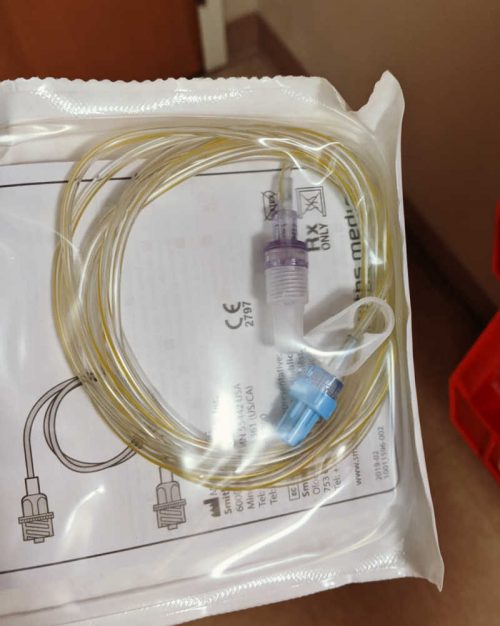Does labor still hurt with an epidural? This post will tell you why you should plan on still having some pain and feeling contractions, allowing you to push during a normal vaginal delivery.
First off, hello! I’m Hilary — many people know me as The Pregnancy Nurse 👩⚕️. I have been a nurse since 1997 and I have 20 years of OB nursing experience, I am also the curly head behind this website Pulling Curls and The Online Prenatal Class for Couples. 🩺 I’ve helped with thousands of epidurals and I know exactly what you should expect from epidural anesthesia pain relief during labor.
If you’re worried about the pain during labor, grab my pain management options right here:
Why Does Labor Hurt?
Labor pain comes from your uterus contracting.
Just like when you’re carrying 12 bags of groceries up 3 flights of stairs — your bicep hurts, so does your uterus.
What does labor feel like?
Contractions (that cause a painful labor) start as cramps and then progress into more painful contractions. They feel very similar to horrible stomach pains that never let up. They are manageable — but many women ask for epidural anesthesia. In the US it is available at most hospitals.
How Does the Epidural Help with Labor Pain?
Modern epidurals place a tube (we call tubes catheters in the hospital) into the “epidural” space in your back — it is fed through the epidural needle. The epidural is administered by either an anesthesiologist or a nurse-anesthetist — not your OB or midwife.

That’s a very technical spot between the “duras” which protect your central nervous system (brain & spinal cord / nerves). The dura are membranes. That’s all it means. One of our doctors said it’s like placing the tube between the banana fruit and peel of a banana. That’s a pretty good picture of it all.
When they inject pain medication (it is similar to the local anesthetic they inject you with at the dentist) in your lower back area, it helps to numb those nerves and take away pain. Epidurals are used in many procedures including:
- Surgery, especially orthopedic
- Pain relief, you can get an epidural injection for back pain, leg, or hip pains.
We now frequently use the epidural for pain relief in labor and delivery.
History Lesson: Your mom might have had several injections with her epidural (I did with my first in 2000), but we now use a pump and the medication is fairly steady. Gotta love advancements in pain medicine! The pump can increase or decrease the amount of medication, so it’s really tailored just to you!
How is the epidural placed?
I have a whole post on epidural placement that details the entire process.
One of the most important things to know is that an epidural is placed by an anesthesiologist (or CRNA, which is like a nurse practitioner of anesthesiology) — not your OB.
I also have a video on how it is done that you can watch on Youtube:
Does the Epidural Hurt?
Getting the epidural can be a bit uncomfortable for a few reasons:
- Positioning — they need you to sit up and curl your back over in order to get the epidural. Some people don’t like how still they need to sit or that position they need to hold to get the anesthesia.
- Numbing injection — they inject medicine (Lidocaine) to numb the area before the epidural — most often this feels like a “bee sting”
- Pressure on your back during placement. Since the “pain” is taken away during the placement, you may still feel some pressure during it as they find the right spot.
In general, once you receive an epidural you may feel cold. The tape may tug at your skin, but most people aren’t bothered by it at all after the placement.
Are there different types of epidurals?
Many of you may have heard of the “walking epidural” — which, is mostly an epidural that has less medication given and allows you to be able to put SOME pressure on your legs. However, as this is also less effective, most providers don’t give it.
And even if they do, you aren’t able to like fully walk around the hospital. You may be able to get up and into a chair.
Some providers place what’s called a combined spinal epidural (CSE) — where they initially place medicine in your spinal area and then pull back the needle and place the tube where medicine will continue to go in your epidural space. This offers great pain relief initially, however not every provider is trained to do it (and especially do it well).
The best epidural type is the one that your provider is proficient at and believes will give you the best pain relief.
Does labor still hurt with an epidural?
The epidural is pure magic. At least, that’s what it seems like to me — on the other side of the patient.
Yes, there is a lot of effort and schooling that have gone into your anesthesiologist to put it in, but once it’s in it should make you fairly numb from about your bra line to your knees.
But it can differ during your labor.
How much pain of contractions does the epidural take away?
Notice above, I said “fairly”.
Yes, you’re still going to feel pressure, some sensation and when done correctly — it will not make you entirely numb.
You read that right — it will NOT make you totally numb.
Yes, you’re paying thousands of dollars for that epidural, but…
It is likely that the epidural will cover about 80 percent of your pain in your lower body when done right.
Why we don’t want the epidural to entirely numb you:
- We still need you to move around a little bit. It’s still important to move from side to side and be able to assist in positioning yourself.
- You need to feel pressure to feel when the contractions are happening — that helps you know it’s time to push.
- That pressure helps you push better and can help decrease your pushing time. If you’re ENTIRELY numb, you aren’t as able to push.
Pro Tip: you should still be able to move a bit with an epidural — if you can’t move at all, you may want to talk to your providers to decrease the rate.
Of course, pressure can feel very much like pain. I can guarantee that the pain you’re feeling is much less than it would be if you didn’t have the epidural, even if you find it very painful.
What does labor feel like with an epidural?
Contraction pain should be 80% lessened with the epidural.
In fact, because they give you extra medications when they start the epidural it actually goes down QUITE a bit in the beginning, and then that 20% comes back once that inital “bolus” of medications wears off.
Most women don’t feel cervical exams much after the epidural either (btw this post has tips for painful vaginal exams).
Also, a foley catheter is required after an epidural, and most people don’t feel that at all either.
That being said, they may feel achy on one side or another as the epidural moves with gravity. If that is the case, your delivery team will rotate you as needed to let gravity affect the other side as well.
Some people do have spots that it doesn’t take, but most people are VERY comfortable with an epidural — and after feeling 100% of the pain, are very glad to take 20%.
Note to remember: You can not plan on the epidural to make you entirely numb. Plan on some pain as your labor progresses as we have found that to be the best plan for laboring mothers. Painless labor isn’t what we want, and you shouldn’t want it either for the reasons mentioned above.
Does pushing hurt with epidural?
It initially feels quite odd. It’s hard to do anything when half of your body is numb. However, pushing out a baby is exactly the same as being very constipated on the toilet (with admittedly much cuter results). Your body quickly realizes that and gets to work.
Pro Tip: Learning about pushing in advance can be super helpful, and yes — it is covered in here.
Can you feel baby coming out with an epidural?
You most likely won’t feel the “ring of fire” that a lot of women experience without pain management. However, as I said above — we can’t take away “pressure” and there is a LOT of pressure in your pelvis and on those tissues as baby comes out.
Those last few minutes of pushing can be a bit uncomfortable, but some women have very little pain during that as well, so it just depends.
Do I have any control over how numb I am?
Yes! Most hospitals allow patients to have a PCA machine for their epidural administration, which means you can push a button to get more epidural medication.
However, I don’t give my patients that button. 🙁
Hahah — it makes it sound like I am mean, but I want to know if my patients are in pain so I can properly assess them (and then help them push the button).
Sometimes you’re in pain because the baby has descended and we need further interventions, etc. As a labor nurse I use pain to help me assess how things are going, if you just keep pushing your button, I never know that.
The other good thing about the PCA machine is we can turn up or down your “base dose” (the machine pumps in a certain amount just like an IV — when you push the button it gives an extra dosage) to make sure that you can move/feel like we need you to. We can really tailor the experience to what your body needs!
Sometimes we need to turn it up as labor progresses or turn it down if you can’t feel your contractions at all during the pushing phase.
Does an epidural slow labor?
Studies show it does slow the pushing process. This is because most often we allow the patients to rest and let their body bring the baby down vs an extensive pushing time. Not that you push for much longer with an epidural.
Also, as I said before, it usually takes a few pushes for patients to “get the hang of it” when they start pushing with an epidural, which may extend pushing time a bit (but if you still can’t feel we can adjust the base doseage).
What about a “walking epidural”?
I have heard a lot about this magical “walking epidural” but I have yet to hear of a doctor who’s ever done one or recommends them.
Epidurals do require extra monitoring of you and your baby, I can’t imagine having a patient walking the halls with them. Also, if you were able to walk, you would likely be also feeling all of your pain (which seems to negate the reason you have an epidural).
Can I have a C-section with an epidural?
If a woman already has an epidural in she can have extra medication through the tube to get numb for c-section.
However, for a normal C-section they use a spinal block — which basically changes which membranes the medication is injected under, the medication works faster and is a bit stronger. I have a post about the epidural vs the spinal on my sister site.
BTW, if you have a scheduled C-section I have a post that has all the things you’ll want in your c-section bag.
What about a CSE (combined spinal epidural)?
Some doctors give a patient a spinal and then place the tube in the epidural space. This is extra helpful when a woman is in a LOT of pain when she receives the epidural.
It is done at doctor’s discretion and preference. Some seem to like it, some don’t. Personally, you want your doctor to place it the way that he/she is most comfortable — so, I’d stick with that.
Get it, stick with that? See what I did there?
Is it possible to have a painless labor?
Yes, it is possible (although not for all women) — but it is not considered the safest or best route for childbirth.
You should have some pain to be able to:
- Move
- Know when it’s time to push
- Have some “feedback” when you are pushing
Does it hurt to have an epidural?
I have a whole post to answer the question — does it hurt to get an epidural
But, in short — I think the placement of an epidural is very similar to the pain involved in your IV start. That at least gives you a frame of reference (as you’ll have to have an IV before you have an epidural). The epidural takes about 30-45 minutes for placement — on average.
Once the epidural is placed, you don’t notice the placement area until a few days later when the shower hits it — it will likely feel like a bruise at that point.
Most people believe that the pain of childbirth is much more painful than the epidural placement.
Problems that can happen with an epidural
Note: Your anesthesiologist should do informed consent during an epidural placement — and should go into ALL of these areas. If they don’t, feel free to stop them and ask the risks and benefits of the procedure they are about to do. Getting an epidural is a personal decision and you should feel free to discuss it with an anesthesiologist before you get it.
Any time the skin is punctured there are inherent risks (these are VERY rare cases especially the last two — but doctors are required to talk about them before doing the procedure):
- Pain at the injection site
- Infection
- Death
As far as infection, that is why we only allow one other person in the room during placement and the doctor will wear sterile gloves and create a sterile field on your back.
That will require putting your hair in front of your body as well as prepping the site with soap (which can feel cold).
Common side effects can include your blood pressure dropping, itching and feeling sleepy.
There are a few other specific things that can go wrong with an epidural (and cause it not to work)
- The catheter can “migrate” — or sometimes just pull out. The doctor will tape your back a LOT, but as we move you, there’s always the chance it could pull out (or could move internally).
- You might have a “window” where the spinal nerves are bundled and the spinal medication can’t get to.
- Sometimes they don’t get it right on the first try and it’s just not effective — in which case, the only thing they can do is try again.
- They can push the needle a bit too far and you can get a “spinal headache” (a pretty severe headache that happens more when you sit up). It happens because you lose a small amount of spinal fluid (which isn’t dangerous, just painful with the headache afterwards). They they can counteract with a blood patch (sounds worse than it is). This is the most common complication of an epidural
Keep in mind that the placement of an epidural has many factors including:
- How you’re positioned (that’s up to you to listen to the doctor and follow orders).
- Your anatomy (and yes, skinny girls are often easier to get it in than larger girls). But, it also has to do with where your fat is located and how your spine bends.
- Doctor skill.
A lot of the epidural is feeling your anatomy, so they can get in the right spot — so that takes cooperation between you and your doctor.
Keep in mind that labor has inherent risks as well and not having an epidural often puts a lot of stress on moms who aren’t prepared.
Alternatives to the Epidural
There are 4 basic pain mangement options (I go over all of them in my podcast on pain management options):
- Epidural anesthesia
- IV pain medication
- Nitrous Oxide (not available at many hospitals in the US)
- “Natural” (or medication-free) pain management techniques
Be sure to speak with your provider about them, so you can know the best pain relief option for you and your delivery.
What you can do to make an epidural block easier?
Things you can do to help your epidural:
- Listen to your nurse/anesthesiologist to position yourself as well as possible (see this post about what labor nurses do).
- Stay still — a moving “banana” (from my analogy above) would certainly be extra hard to get it right!
- Be realistic — as I said above — your pain will be 80% taken away.
- If you want an epidural, be sure to let your providers know, and feel free to put it in your birth plan (so the nurse can watch out for the best time for you to get it).
- Give your nurse as much info as you can. Did you ever get pain free, is it in a specific spot? That helps us know if there’s anything we can do?
I’d also recommend having some basic pain management skills going into labor — whether you are planning on an epidural or not. I share one of women’s favorite ways here. 🙂
And that, my friend, is the real magic (because you’ll need pain management techniques for the next 18-40 years with that child). 🙂
How long does the epidural last?
The short answer, as long as you want (as long as the tube stays in the right place) –but I have a whole post on how long epidurals last.
The hope is definitely that the epidural lasts so that you don’t feel the baby coming out.
When Should I Get the Epidural?
I have a whole post on my sister site The Pregnancy Nurse on when is too late to get the epidural.
Most people do best when they get it after the first stage of labor, but discuss with your providers when they think the right time is for you during the labor process.
Labor Pain Management Classes
Ok, we’ve talked a LOT about the epidural. Most people find it helpful to go through the entire process together with me explaining what each step is for and when you’ll likely need to do. That’s all covered in the pain mangement section in here.
The Online Prenatal Class for Couples, has a great pain management bonus video that will show you:
- Breathing techniques
- Positioning to help with the pain
- Household items you can use to help (like a heating pad)
Imagine me, right now, waving pom poms in your face saying GET A PRENATAL CLASS!!! Both of you taking one together is going to make you feel SO much more comfortable at delivery — but you don’t have to take my word for it #readingrainbow
In short, a bit — if an epidural is working correctly — it should take away 80% of the pain.
So, that’s the nitty gritty on what you should expect from your epidural. Just a reminder this is part of a series all about labor epidurals. don’t miss the others:
- Does it hurt to get an epidural?
- Epidural during Labor — the procedure & more.
- How long should my epidural last?
Have you had an epidural? Tell us in the comments what YOU felt!













Amanda says
I don’t know how else to state this, but do you still feel the “ring of fire” vaginal burning sensation with the epidural. I’m due in 8 weeks and that scares me more than the idea of contraction pains.
Hilary Erickson says
Most people don’t — at least not as bad as if you go entirely without an epidural but a lot of people feel a great deal of pressure in that area.
Honestly, I think knowing that it is truly normal helps a whole lot.
I do have a whole chapter on pain in my prenatal class, so — maybe check it out. 🙂
Dana says
My second epidural was like this. When I started squirming when my nurse was trying to put in my catheder we knew I was in trouble to say the least. And then my baby came so fast there was nothing I could do but push through the pain. I should’ve gotten a discount on that epidural bill lol.
Hilary Erickson says
I always feel like they should get a discount. I certainly would’v asked for one. 🙂
Christine says
The epidural made everything so much more manageable. The pressure that you feel is a manageable pain, where as the contractions were overwhelming. I couldn’t cope with them. Just an FYI though. If they need to use forceps, even with an epidural, let me tell you, that’s the worst pain I have experienced in my life. If this happens, remember it’s only about 5 minutes. Just focus on your breathing and you will get through it.
Hilary Erickson says
Yeah, it is a short period… but an intense one. 🙂